#dm advice
Text
youtube
I think this is the most I've ever agreed with Colville on anything, which is saying something because the man is a genius.
TLDR: Running smaller adventures (like, the span of a level or two) is healthier for your games in the long run because it gives players a sense of accomplishment. The endless mega adventures are pushed by publishers because they make more money, but promote bad design/play habits that not only put undue expectations on everyone involved but also rob the story of vital momentum.
What I was struck by in the video was how much the non-d&d media I've grown up with (open world games, streaming series, epic fantasy books) have coloured my expectations for how long the default d&d game SHOULD be. Sure, I can keep a whole campaign's worth of information in my head down to the accents of the shopkeepers in all the settlements we've visited and the machinations of courtly power players we'll never get to meet, but I can do that because I'm a freak with a head for details and my players mostly aren't.
By stretching out my stories too far I was diluting their effectiveness, as vital information and emotional beats were lost over weeks and months. I was inadvertently inflicting marvel-fatigue on my own party, putting too much work into setups that I might never get a chance to land because building up to big shocking twists and AHA red string moments was what I was conditioned to expect.
I know I was doing this because it's the exact same thing that I see happening with a lot of media I've tried to get into in the recent past and ending up bouncing off of. Just like with marvel (especially the later phases) there's a constant feeling of "what you're looking at doesn't really matter, this is just to set up to something that's going to pay off later", which is so pervasive that it prevents me from getting genuinely invested in anything. I hate that shit, and I would definitely hate inflicting it on my players.
I also applaud Matt here for repeatedly bringing up the idea of "the health of the game", as it's an umbrella term that can not only be used to describe a lot of good practices, but a mindset that we should take around our own tables for ensuring everyone (us DMs included) are having a good time now and into the future.
124 notes
·
View notes
Text

No idea the source, but here have this.
Edit: Source is Pretendo Games. Thanks to @happilyeveraftereveryday for finding them!
2K notes
·
View notes
Text
A rule I have when DMing games is that a player can always choose to fail. If they think it'll make things more interesting or if it's funny or fits the character or if they just want to see what happens. Sometimes I'll give them a little reward for doing this, but I've found that once you establish that failing can lead to interesting consequences, players get on board.
453 notes
·
View notes
Text
If you ever feel like maybe it's a little embarrassing to do voices in d&d, like maybe you won't do it good enough or people will think you're weird, you will never be more embarrassed than my college rhetoric TA. This girl was maybe 23, tops, pale white girl with red hair, stood out in the room like a sore thumb. She was smart, don't get me wrong. Had the course material memorized (probably better than the professor, honestly). But the first time we went through the "lineage" of Greek philosophers and got to Cicero she busts out with the best Cicero (TeS) impersonation I've ever heard in the middle of the class. Not much, just a "what?! Cicero?!" Like someone was accusing her.
No one expected it. The Prof looked bewildered. She mumbled her explanation about how she and her bf had been playing a lot of Skyrim lately.
Anyway. Tl;Dr. You will never be more embarrassed than Cicero, my rhetoric TA.
#d&d#dnd#dungeons and dragons#ttrpg#dm advice#gm advice#doing silly voices is a gift#treasure those silly voices that your players and gm do
325 notes
·
View notes
Text

Is this balanced? A bard wanted to use this homebrew spell... I think it's a little bit too much damage, but I need help rebalancing
60 notes
·
View notes
Text
if you are a dungeon master (or even a fantasy author/worldbuilder of any kind) and you don’t know about donjon let me make your life a million times easier
want to make a fantasy calendar with your own year-lengths, weeks, months, and lunar cycles? https://donjon.bin.sh/fantasy/calendar/
need to come up with some medieval town demographics? https://donjon.bin.sh/fantasy/demographics/
want to make a map and layout of a city/town? https://donjon.bin.sh/fantasy/town/
want a fleshed-out tavern complete with menu, innkeeper, patrons, rumors, and secrets? https://donjon.bin.sh/fantasy/inn/
leading your players through a dungeon and want to customize the size, treasure, layout, theme, etc? https://donjon.bin.sh/5e/dungeon/
tired of creating lists of magic items for different shops to sell, or hoards to be looted? https://donjon.bin.sh/5e/magic/shop.html and https://donjon.bin.sh/d20/treasure/
even a customizable initiative tracker! https://donjon.bin.sh/d20/initiative/
and that’s only scratching the surface! I really recommend all dms check this out. oh, and it’s completely free!
#donjon#dm#dungeons and dragons#d&d#gm#worldbuilding#cr#dm tips#dm advice#ttrpg#game master#dungeon master
399 notes
·
View notes
Note
Curiosity question if you don't mind from a newbie dm. How do you deal with tpk as a dm ? Where you super stressed as it was happening or was it ok cause you could communicate with the players ?
this is the first time i've ever had a tpk happen. several things happened and several things contributed to the way i ran things and why i think my players are okay with the outcome and i'll talk about them now. some of these i think are tips that can be applicable to dming, some of them are just personality things, and some of them speak to group synergy.
i know this party well. i know the PLAYERS at this table that i was doing this campaign with well and we know how to communicate, 3/4 of us dm for each other and we are all typically good at knowing what each other will enjoy
we communicate well, even if it takes a minute out of session. for example, in another game we play where i'm a player some of the decisions i was making as my pc were bringing down another player, and while we all agreed at the start that it was okay, things changed, and so i changed the way i was playing my character and they're swapping out their pc for awhile to play a different character.
i think it's important to note with the two examples above, your mileage really will vary when it comes to communication with other people because one's capacity for interpersonal communication has nothing to do with their enjoyment of the game. likewise, you might have great friends but realize you don't enjoy playing d&d with each other. things happen.
i think something any ttrpg player can keep in mind is that just because you like someone doesn't mean you like playing a 4 hour board game with them once every two weeks and viceversa. just because you get along to play a game doesn't mean you need to be best friends with someone you don't feel that close to outside the game.
some actual thoughts of mine regarding tpks and what happened in session that i feel like made it a successful session instead of something that felt horrible and unfair
i did not make the encounter with the goal to kill my entire party or even to kill one of them. i wanted a hard fight, cr is hard to balance, usually you have to punch way above your party's weight class to have a fight feel scary and challenging. that is what i was doing. the fight was very winnable. it just came down to roll of the dice. i think they could've taken them down but that's just not the way it turned out. the encounter itself did not feel hopeless, that is important. the alternate to this is i am not against, as a dm, flagging that a fight IS hopeless and that the party should flee. that is run very differently than how i ran this encounter, i was not signposting for them to run, i thought they would win.
when the first player dropped and then rolled a nat1 i asked them this: by raw this is failing two death saves, however, if you want this to be an automatic death you can choose that. i do not want to choose for you, i want you to make the choice that is fun for you. pc death is not fun unless you have fun with it.
and then to keep a bit of mystery, i direct message'd them where i thought we could take their pc's story if they died / what the 'resurrection quest' could be. the player ended up deciding that auto death could be fun.
at this point, i did not know that i would successfully knock the other two players. and when it became clear that i could and was on the cusp of it, i asked them both something similar. do you both want to roll death saves and fight to the last breath or do you want to die. here's what will happen. they were excited by the death option.
my players chose to tpk. their characters did not, narratively they did not, the challenge was fair but hard and they failed narratively. failure should never be the end and should not be a punishment. the story moves forward. i presented an idea for where the story could go from the failure and they were enthusiastic about it.
after session i also checked in with the group and said, hey if you get second thoughts about this let me know and we can retcon that fight. i do not want to play a game that is not fun for you. as it stands now, they're all really excited about the idea of clawing their way back from the grave whenever we pick up a new story arc with those characters again.
and that's really what it boils down to for me as a dm whose spent a lot of time as a player in the game. pc death is not fun unless the player is excited about it. if they aren't okay with it, it will not be fun for anyone involved.
the game is about roll of the dice, the game is about story, the game is about mechanics and challenges and puzzles, but most of all it is about having fun. so if something is not fun, you don't have to do it.
i could talk forever about how i feel like there are some dms who take so so much pride in their intricate plots and ideas that they keep secret to their last breath without actually collaborating with their players which i think is actually a detriment.
#dm advice#i can talk more about my opinions on PC death in general and what i call 'resurrection quests' if you'd like and this is sort of a mismash#of my opinions on party synergy and above board communicaiton as well as improv from the dm chair.
91 notes
·
View notes
Text
A rant about roleplaying and taking advice from goblin eratta
Look, look, I get it. D&D is famous for its goblins and whatnot. But trust me when I say, pathfinder goblins are so much better art wise and writing wise than D&D's.
For example:
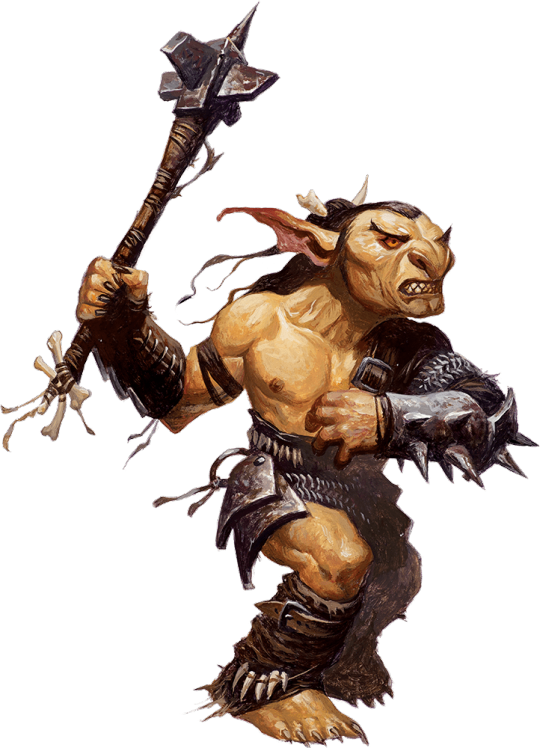
This is the D&D monster manual illustration for goblins.
Firstly, orange, chunky, this guy's has the aura of "might attempt tactics" about him. He looks more like he'd try and throttle you rather than run in fear at the sight of a large sword. The head is oddly shaped as a goblin's head should be, but it looks more lumpy warrior face than gobliny. The armor is far too organized. The ears are droopy and smooth. This is not goblin, this is a small ork at best.
Yeah they've got a brief section explaining the hobgoblins and bugbear relations, a little bit about goblin language, but not much as far as flavor text.
Now pathfinder goblins...
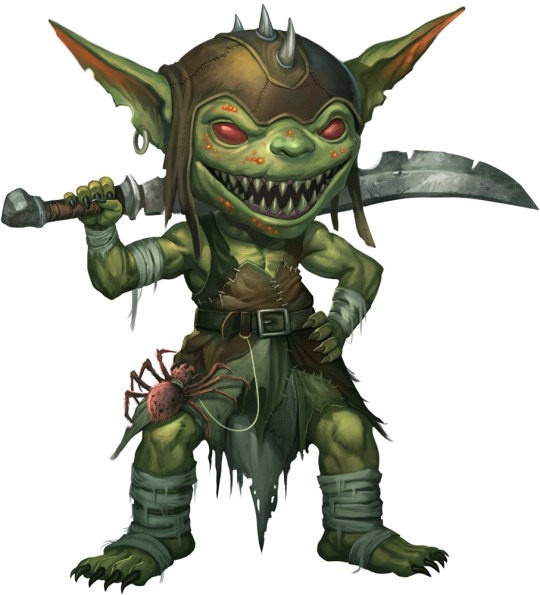

These are the quintessential goblin.
Green, scrawny, cowardly, chaotic, looks like they scrounge their clothes from local landfills, oblong football head, big ol' perky pointy goblin ears; *chefs kiss* perfection.
Pair that with the tidbits of goblin lore from pathfinder and ough you've got something good going on.
They are afraid of and have a burning hatred for horses. They typically wield 'horse choppers,' basically big cleavers or axes, instead of daggers or shortswords like in D&D.
One of the few occasions they'll organize and come up with plans is if they're pulling pranks or massive attacks under the command of a warlord or leader, of which they will occasionally get on accident.
They don't have to be bound to a leader, though, sometimes goblin bands can manage just with cooperation alone.
Goblins are crafty little buggers, laying traps and building ramshackle contraptions to get the jump on their foes. They prefer going for sneak attacks or surprise attacks over head on combat. They know they can't win a fair fight, so they fight unfair.
If you invade a goblin dwelling, they'll usually retreat on sight, but not always because of cowardice. Sometimes, they do so to lead you into their traps or to get you into a bottleneck. They can come up with strategies, but usually only if it's below the belt and breaks all the rules of engagement.
War crimes and chaos, if they aren't committing one of the two, they must be defective goblins.
There are occasions in the pathfinder modules where it encourages the DM to have the goblins get into antics over attacking the players. One such example is during a fight at a festival, it reccomends having some of the goblins focus on the festival food over the potential threat of the player characters, since they'd find the food much more important.
Some I came up with include swinging from ropes and attempting to grab players' hats, hoods or helmets, having some attempt to crawl into the clothes of the players instead of attacking, or even just crawling and wallowing all over them like opossum babies. My personal favorite and what got a huge laugh out of my players was having one find a big cast-iron stew pot and putting it on its head. It made it blind, but it also gave it more armor, making it sort of run at the characters to attack but not being able to hit them because it couldnt see, and the swords and maces bouncing off the pot due to the additional armor made it difficult to kill him. Pair that with the constant deafening the goblin would endure with the "bong" sounds any impacts would make, causing it to panic and run around more, bumping into walls and people alike.
What I love about these little tidbits of fight modifications is that it exemplifies the "combat doesn't mean roleplaying is over" factor many players and DM's either have never considered or just miss entirely. Many people complained that "man, if only combat in D&D was like the movie," and to that, I say: it can be, if you stopped being boring and made it that way! Describe what your character does! Add flavor to it! An action is 6 seconds. You can do so much in six seconds while still attacking! Describe the actions you take! Take free actions to do little flairs or flourishes! Show off! Fight with elegance, fight with brutality, fight with conniving, fight with confidence! Spend an action doing something in character instead of attacking! Yes, it's not efficient, but it's more interesting and entertaining to take a fall for a storytelling moment instead of spending yet another turn attacking. Flawed moments are far more interesting than constant perfection, that's why you use dice instead of always having a nat20 every turn. Use the failures to your advantage, show how your character reacts to a bad situation or rough luck!
Don't just spend the time in between your turns waiting for yours to roll around. Instead, be planning the sick ass thing you'll do if the dice allow you to, or the reaction to the adversity if they don't! And, sometimes, break away from the "I swing my sword, I cast a spell, I eldritch blast" combat! Push enemies off of elevations with the push action! Flip a table over to get cover from spells and ranged attacks!Grapple them to make it easier for your team mates to hit them or use them as a human shield! Grab a big rock off the ground and chuck it at someone! Cast a spell that doesn't just do damage!
Broke:
"You shoot a fireball at the thief as he attempts to escape."
Woke:
"As the the thief runs, I go to launch the fireball at him, but notice the mirror to the left of me. My narcisim gets the better of me, and I end up taking a second to check my hair. Ah yes, dashing. Oh, wait, I was doing something. I manage to tear myself away from the mirror long enough to barely catch the thief in my fireball as he attempts to flee."
So, I say all that to say this: players and Dms alike, roleplay during combat! It's a roleplaying game, not a roleplaying game+formulaic tabletop war game any time there's combat. And hey, if you ever find yourself needing inspiration on how to make fights more interesting in your tabletop games, grab a couple low level modules off Paizo, and read up on Pathfinder goblin scenes, they pay extreme dividends.
#skitposting#dungeons and dragons#d&d#pathfinder#goblins#roleplaying advice#roleplaying#dm advice#player advice
158 notes
·
View notes
Text
DM Pro tip - the "Recap" at the beginning of your session is your excuse to be EXTREMELY passive aggressive to your players and what they DIDN'T do.
#dungeons and dragons#being a dm#out of context stuff#dying inside#someone help me#brennan lee mulligan#critical role#lol#DM tips#dm advice#dungeon master#dnd campaign
88 notes
·
View notes
Text
Hey all, This is my first Tumblr post ever! I'm pretty new here, but I'm hoping to share some DM techniques, tools and tips and to make some new friends as well! Feel free to send a chat request (an ask[?]) if you're interested!
With that aside, on with the post!
Better and More Meaningful Random Encounters!
Random encounters are a staple of DnD, they are expected to be there during exploration as a way to make the world feel alive, to have it have an aura of adventure and danger, to eat up party resources and put pressure on the PCs to make interesting and important choices, and also as a way for a DM to reasonably 'stall' the party with a quick and easy situation.
Usually, it ends up something like this:
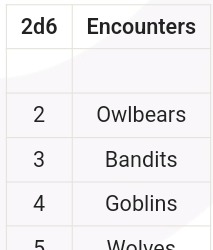
There's just one problem with most random encounter tables though, it's so easy for them to be GOSHDARN BORING! Especially for a newer DM.
Making them interesting becomes gambled improv on the DM's part if they're not used to it, and it's hard to keep track of the important factors that need to be kept in mind
Luckily, I ended up finding a great source for random encounters from 'Dungeon Masterpiece' on YouTube, and I integrated it into my own DMing. I figured that I'd share it here for any that want to work it into their own sessions as well!
After adjustment, a single table can account for multiple entire sessions of in-depth worldbuilding and fun without getting dull!
Sources:
Source 1 (Creating interesting Random Encounter Tables):
youtube
Source 2 (Making Random Encounters reflect your Worldbuilding):
youtube
There's 4 major methods we can use to improve the Random Encounter table
1. Make the table a straight 1dx roll.
2. Adding 'depth'.
3. Adding meaningful encounters.
4. Prerolling and/or Multirolling.
You can also check out the "Where to Start?" section for some direction to make getting it down and prepped all easy peasy!
1. Straight Roll:
Its enticing to go for 2d6 or the such in order to add non-linearity to the rolls, but these sorts of adjustments only end up making one or two encounters extremely likely and leave all others in the dust, it often ends up defeating it's own purpose of interesting randomness.
In the previous example, it was extremely likely to only get Wolves, Barbarians, Orcs, or Spiders, from a table of 12! A straight roll would serve us much better. The rare rolls are already rare enough as is!
Simply enough, adjusting the original example by replacing the 2d6 with 1d12, it'd become something more like this:
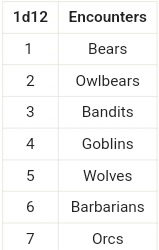
#2. Adding Depth:
We can add more columns in the encounter tables. These columns will represent different aspects about the encounters that we can roll on separately!
Usually it can be difficult as a DM to naturally come up with motives for the encounters, showcase the worldbuilding and have it all come together.
This setup can give you a solid guideline on how the creatures/people think (if any), and also sets up the overall area so that you get an idea of what events tend to occur there as a result of its occupants.
We want to add 3 more columns to the tables to convey different aspects of the encounter. Fill in these new columns corresponding to the expectations of each encounter.
We'll roll each of these and combine them, then we'll interpret them to make a robust, in-depth random encounter with truly unexpected results!
I recommend rolling alot of complete encounters at once and interpreting the context to the vast general area the party is travelling in.
i. Behaviour: How the creatures act. Are they friendly, scared, aggressive, curious, mischievous?
ii. Complication: Something behind the scenes in the encounter. Do they have sick young? Broken equipment? Are they starving?
iii. Significant Impact: This is a tick box, and will only be present under ONE of the rows. It will be rolled like the other columns, but ONLY once. It signifies which encounter is the Significant Encounter
The Significant Encounter will have its encounter's presence prominent amongst all the other random encounters in the area. There could be burn marks and carcasses from a rampant dragon, or a goblin raid leaving tracks moving through the area. Which is the most impactful of the different encounters?
Adding this to our previous example would expand it to:

Rolling this would give us things like:
Significant encounter: Owlbears

Note that the significant impact shows that the Owlbears are a massive problem in the area. Perhaps the Owlbears are agitated for an unknown reason, and are unnecessarily aggressive.
The significance of Owlbears gives us context to the second one as well! Perhaps the hunters raided an Owlbear den, and adopted an Owlbear cub from there as well.
There could be uneaten carcasses, ravaged trees, less wildlife, etc around these parts.
Note how much sheer CONTEXT these columns add to our encounters. It's invaluable!
3. Adding Meaningful Encounters
Usually random encounters tend to be rather mundane and very one-note.
There's usually some general wildlife and monsters, different disparate factions without any rhyme or reason, and maybe a general non-combat encounter or two, but these don't really tell us about the area or its surroundings at all by themselves.
Instead, we can add in wildlife and monster encounters specific to the biome, non-combat encounters, and encounters of nearby factions and/or settlements to the table, and we can even add environmental encounters in there as well.
Note that we're not tied down to 12 encounters, and can expand it ad infinitum according to our need of diversity in our encounters.
Just add in specification and connection, and suddenly the dominos all fall into place.
Lastly, we'll also be adding in 'DOUBLE TIME' which will let us roll on everything twice, and make it so it's a double encounter!
Thus, the table can instead be adjusted to:
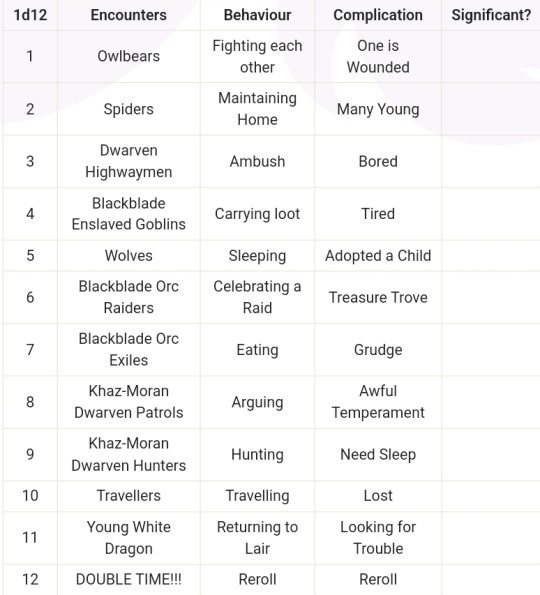
Note how each and everything has its relation in one way or another, but through the sheer variance, they remain truly random and novel.
4. Prerolling and/or Multirolling
Lastly and this is just something that I do, but that I found gamechanging. Be sure to pre-roll 5-7 encounters for each session, for the general area the players are going to be headed in.
Note that you don't need to really prep anything at all, just interpret all of them on a surface level as a buffer.
Also note that you don't need to use all of them if they're not needed. The foreshadowing and signs are worldbuilding and having secrets that the players don't unravel is just as useful as the ones that they do, perhaps even moreso. It adds depth and detail beyond the scope of what the party will encounter
It simply let's you get an idea of the connections between encounters, allows for foreshadowing, and acts as a deterrent to getting caught off guard.
Even if you roll mid-session, I recommend calling for a 5 minute break, rolling 5-7 encounters at the same time and interpreting them and their connections before resuming the session.
It WILL make a difference, trust me
Where to start?
It can be difficult getting inspiration or direction to get started in creating these random encounters, and sometimes you don't want to go through the hassle of thinking them up from nothing
For some great conceptual headstarts and examples for these tables, you can check out 'Worlds Without Number' and it's:
- Page 205 (Great general templates for encounters differentiated by broad creature types such as Beasts and Monsters, Sapient Monsters, and Humans)
- Pages 206-219 (For inspired locations to occasionally run rare encounters or groups of encounters in. This works best with flexible/discovered worldbuilding given the significance of some of these, and you also want to add these in sparingly to keep them significant)
- Pages 246-247 (These pages have great templates for the kinds of encounters and situation to be included in the tables, and it can be expanded vastly, and certain options can be selectively and repeatedly chosen to meet our needs. Mood works well as a complication.)
There might be other pages that are useful as well for these sorts of random encounters in the wilderness that I haven't come across yet. If so, give them a shout out and I'll be sure to add them in. It's worth checking it out in its entirety for some great tips!
Conclusion
Again, credit goes to Dungeon Masterpiece and Worlds Without Number for excellent adjustments. This has been quite long, but I hope you stuck around till the end.
Many a session have been made easy but complex ever since this was introduced and I hope that this helps you out as much as it helped me in my prep and improv!
Feel free to give any advice in formatting on Tumblr, or any feedback on the post itself. It really means a lot to me, thanks!
#dm tools#dungeons and dragons tips#dungeon master tips#dm advice#dm tips#ttrpg#dnd#Youtube#dnd resources#gm tips
58 notes
·
View notes
Text
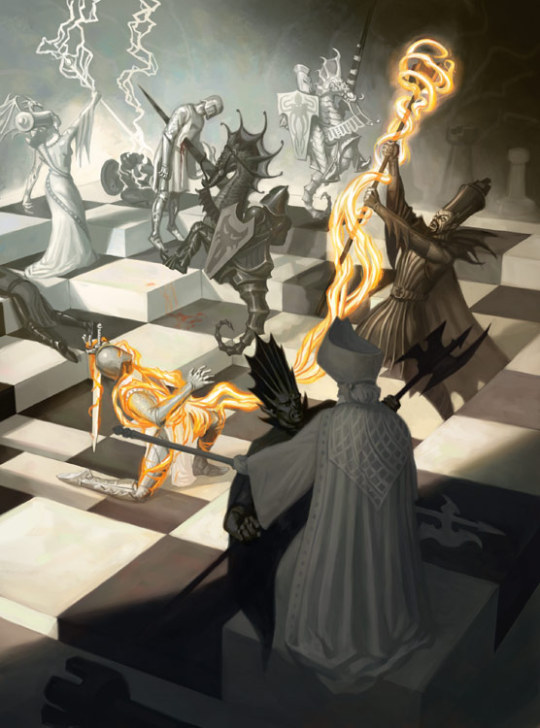
DM Tip: Lining up the Pieces
A few years ago I saw a video that changed the way I design combat encounters, using chess pieces and 4th edition monster roles as a handy way of conceptualizing the enemy roster and making better combat.
I’ve wanted to refer back to it for ages now, but I can’t seem to find it. As such, I’m going to reproduce it’s wisdom here for everyone’s benefit and hope I can find the source one day. ( I feel like it was a Matt Coville video, but my searches have turned up nothing. Seriously, if you can find it I will be extra grateful).
TLDR: You can break down enemy combatants into six (ish) roles represented by different kinds of chess pieces, and you can mix and match them when designing encounter to create fun tactical scenarios. You can also use this as an alternative to CR picking a “budget” of these enemy roles based on how many players are in the fight. Check out the types below the cut:
Infantry (pawn): Generally weaker and mechanically simpler than any other type of combatant, the infantry uses teamwork or sheer numbers to overwhelm the party. This can be anything from rank and file soldiers to a necromancer’s skeletal minions to a pack of wolves, anything that takes up space on the battlefield and prevents the party from targeting who they want or generally getting their way in a fight. 5e combat is a numbers game, and the infantry is there to swing the numbers in the enemy’s favour (until the party cut through them to even the odds). Infantry likes battlemaps with chokepoints they can hold and crossroads they can use to outflank opponents. When budgeting they’ll have a balance of 2 infantry per 1 player they’re matched against , but the weaker they are, the thinner you can spread them.
Brute (rook): High defence, high offence, the brute is an outright threat that the party should not want to take in a head to head fight. Giants, beasts, constructs, and heavy armoured warriors are your traditional brutes, but you could also go with a buffed to hell battlemage getting all up in the party’s face. Conversely, every brute has some kind of weakness that the party can exploit. They might be slow, or be unable to maneuver as easily, or like a werewolf, fiend, or troll, have particular weapons or damage types that overcome their natural resilience. Their job is to force confrontation, blunder into the middle of combat and force the party to act defensively rather than proactively. They soak up the party’s frontline’s attention while forcing the mid/backlines to scatter under the threat of too much raw damage. The brute Likes open spaces where they can have a direct path to the party and dead ends they can corner their targets against. Budget: Around 1 per 3 players
Skirmisher (knight): A very broad type of opponent, the skirmisher’s job is to bully the party’s weapsots whenever they’re exposed. They can do this by being ranged fighters ( traditional archers, magic users) or by being highly mobile (stealthy, mounted, flying, teleporting). They’re the bane of the party’s backline, generally targeting whoever has the lowest armour/or least health, then using their evasiveness to deny any kind of retaliation when the group rallies to protect their squishy friends. Skirmishers have great offence but are generally pretty weak, made helpless when you can deny them their movement/terrain advantages. Skirmishers like unfair fights, terrain that gives them a movement advantage, cover, or allows them the highground over their foes. Budgeting: 1 per 1-2 players.
Controller (bishop): The controller’s job is to fuck with the party, Either by locking down some of their stronger options (counterspelling, mind control, status effects, grapples), by manipulating the battlefield in some way that disrupts planning (aoe spells to prevent grouping together, summoning to reinforce numbers, barriers and banishment to single targets out), Or by advancing the baddies’ goal while the party is otherwise occupied (the cult priest finishing the disastrous ritual, the master thief making off with the mcguffin) forcing them to split their attention. The controller likes to distinctly be away from combat, and will usually be on the otherside of some kind of hazardous/hard to bypass barrier, sometimes of their own making. Budgeting: 1 per 2-3 players:
Support (king): Usually a healer, bodyguard, or some kind of buff-bot, the support wants to piggyback on other sorts of units or make them better at doing their jobs. Generally this means they’ll ignore whatever the party is doing to focus on staying with effective range of those who most benefit from their abilities. Supports will stay back in safety while throwing out buffs, bodyguards will put themselves between the party and their designated defendee. They tend to prefer whatever type of terrain most benefits their partners. 1- 2-3 players
Elite (queen): Something to be reckoned with, an Elite mixies the strength and abilities of two other kinds of combatants and uses both to devastating effect. Combine a brute and a support for an unstoppable frontline commander, or infantry and a skirmisher for an elite striketeam that attacks in perfect coordination before fading back into the shadows. Mix and match for whatever combination you think would be most interesting for a situation, then supplement it with a different unit or two for contrast. Elites make up your traditional “big bad and minions” bossfight, without escalating to the full party challenge of “solo” monsters. Budgeting: 1 per 3-4 players.
Picking the right Pieces:
Generally what you're going to want to do when planning a combat is to first think of what the baddies are trying to acomplish with the fight then pick 2-3 different types of baddie that you think would work well in concert to achieve that goal. "Kill the party" is an all too common goal, but you could easily imagine others that provide for dynamic stakes:
A group of forest bandits intend to rob a caravan, so they unleash a captive warbeast as a distraction while their archers rain chaos from above (Infantry, brute, skirmisher)
A villain abducts an important npc into a carriage while their dutiful muscle run interference (controller, brutes)
A necromancer hurls curses from behind a barricade of gravestones while their undead minions pour from surrounding tombs ( Controller/infantry)
While the party is ambushed by an archer in a tower, a cloaked figure waits in the underbrush, waiting for them to thin out and begin picking them off one by one (paired skirmishers of different types)
After the fighter is tricked into single combat against the mounted arena champion, the rest of the party will have to search the crowd for the caster secretly channeling healing magic to their opponent. ( combined brute/skirmisher elite, support)
Once you've got your pieces picked out, you can start designing the battle arena taking the desires of each combatant into account while also throwing in any environmental flourishes you'd like to enjoy.
As an added benefit for DMs like me who don't have the inclination or budget to collect huge batches of minis, it's SUPER easy to pick up a second hand chess set or two and use them as stand ins. Your players will have an instinctive understanding of what each piece does which will help them understand the roles outlined above.
Artsource
273 notes
·
View notes
Text

what do you think?
pointsofinspiration.com
#dnd#dungeons and dragons#ttrpg#dungeon master#dm tips#dnd5e#dm advice#pathfinder#fantasy#dungeon master tips
91 notes
·
View notes
Text
I often see references to the concept of a Forever DM in discussions of my favorite hobby. A hapless person who would love to play D&D, but is forced to forever manage campaigns instead because they don't know anyone else who will step up to do it.
I feel fortunate to not have experienced this in my own life. In the gaming groups I've been a part of, there's always been a rotation of Dungeon Masters, with multiple people happily volunteering to run the next game.
Perhaps I'm just very lucky, but I also feel like the concept of a Forever DM the way it's usually presented is kind of like a self fulfilling prophecy. If you see DMing as a chore that needs to be done in order to facilitate the fun of others, you're not really presenting it as a desirable role. You're discouraging others from giving it a try. And it's a shame too, because being a Dungeon Master is genuinely very fun and fulfilling. And it's something you can spend years honing your technique and getting better at, but you don't need to be an expert to enjoy yourself. The process of practicing is itself very enjoyable.
So I guess what I'm trying to say, is that if you see yourself as the Forever DM, and that's not something you want to be, than you should try reframing your own perception about the role. The DM is a player too, and the more fun you have, the more likely someone else is going to see you and say "I'd like to try that".
168 notes
·
View notes
Text
DM\GM Tip on Roleplaying Stuff
🎲 GMs, there’s always a way to say yes to what the player wants to do.
🎭 Roleplay isn’t always about getting what you want but being given the chance to try and it doesn’t mean success is always possible.
💪 I once had a Barbarian whose whole purpose was to fight the biggest things he could find.
🌋 The first time he saw a Volcano, he wanted to fight it. Both me and the player knew that wasn't possible. But I gave him the chance to play this out.
He attempted to scale the side while his party looked on, dumbfounded. He eventually fell...multiple times. Until he swore, he would return when he was stronger to exact revenge.
Sometimes players will want to do things and not understand that it's not possible yet -- could be due to power levels, influence, ect.
🧙♀️ Don't just deny them the opportunity. Talk, communicate expectations and give them chances to work towards those goals.
#Dungeon Master#Game Master#DnD#D&D#Dunngeons & Dragons#Dungeons and Dragons#TTRPG#DM Tips#GM Tips#DM Advice
113 notes
·
View notes
Text
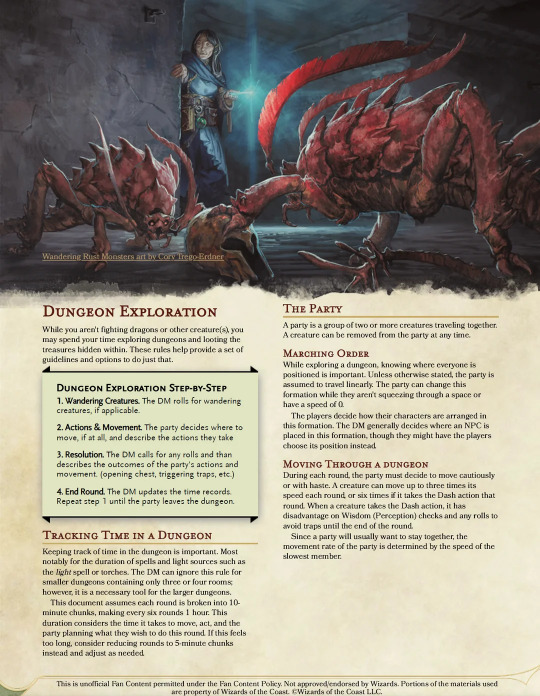
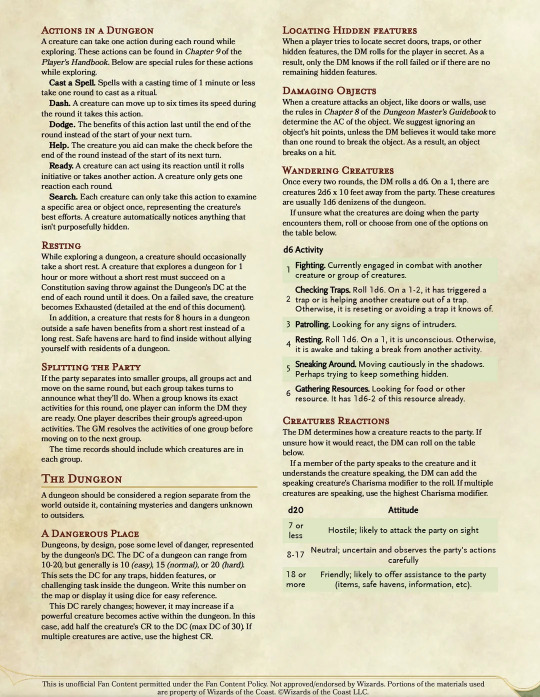

Dungeon exploration by O-kra on reddit
57 notes
·
View notes
Note
any spare tips for first-time DMs? (can be about anything — or like, what’s something you wish someone told you when you first started DMing?)
yknow how when postgrads reflect on uni and they're like OH my god do the reading. just do the reading just shut up and sit down and do the reading. d&d is very much the same principle. just read the module. just read it over and over and over again. highlight the important bits. just prepare the statblocks and read them over, no AGAIN and then reread the module.
or, if you're homebrewing almost entirely. just write the thing. find every name generator and treasure generator and every other generator you could need and write the thing. steal RUTHLESSLY. if you're not recording it as a podcast or making a profit from it just take from everything. take entire plots of books or movies or tv shows (the more obscure the better, especially if your players haven't read/seen it) and copy the parts you like. do you think you could have written a better adaptation of a niche fantasy novel? fucking PROVE IT. and then PUT YOUR PLAYERS IN CIRCUMSTANCES. read other tabletop systems!! use dmsguild for the love of FUCK use dms guild. pirate other d&d modules (and look back at earlier editions!!! there is some gold in 3.5e). DON'T think you have to come up with theeeeee most unique and original and special d&d world literally no one is paying you to do that and copyrighting is for losers. this is fun times at your dining room table/desk. search "d&d maps" on pinterest or search for unique and rare items for loot, and then base entire campaigns around these set pieces. i ran a 10 or so session campaign around each member of the party fighting someone who owned an artifact or relic that fit each of their builds and then upon gathering these items they fought a ghost council of guild leaders and apotheosised themselves into their place on accident. and it was FUN.
106 notes
·
View notes